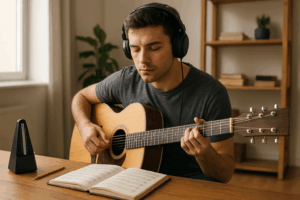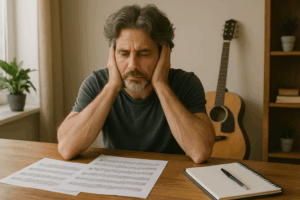Music is not only about playing the right notes—it’s about expressing emotion, telling a story, and connecting with your audience. Whether you’re performing on stage or recording in the studio, musical expression is key to making your performance memorable. But how can you develop and improve your musical expression? In this article, we will explore strategies to help you bring more emotion and depth to your playing, creating a more engaging performance.
1. Understand the Emotional Context of the Music
Every piece of music carries emotional weight. Whether it’s joy, sadness, excitement, or sorrow, understanding the emotional message of the music you are playing is crucial to expressing it effectively.
How to Connect Emotionally with the Music:
- Analyze the Music: Before you start playing, take the time to analyze the music. Look at the dynamics, tempo, and rhythm. What emotions are conveyed by these musical elements? What mood does the piece evoke? Understanding these aspects will help you connect with the music on a deeper level.
- Consider the Composer’s Intent: Try to understand the emotions the composer intended to express. This will help you align your playing with the mood of the piece, whether it’s a melancholic melody or an energetic, uplifting composition.
- Personal Interpretation: Don’t be afraid to inject your own emotions into the music. While it’s important to respect the composer’s intentions, your personal interpretation will give the piece a unique touch and make it feel more authentic.
The more you understand the emotional landscape of the music, the better you’ll be able to express it through your performance.
2. Work on Dynamics and Phrasing
Dynamics (loudness and softness) and phrasing (how musical ideas are shaped and presented) are essential tools for musical expression. They help you add contrast, build tension, and create moments of musical storytelling.
How to Improve Dynamics and Phrasing:
- Vary Your Volume: Practice playing pieces with varied dynamics. Instead of playing everything at the same volume, experiment with playing softly (piano) and loudly (forte). Use crescendos (gradually getting louder) and decrescendos (getting softer) to add depth to your performance.
- Use Phrasing to Shape the Music: Phrasing is like the punctuation in a sentence—it helps the listener follow the musical “story.” Focus on how you begin and end musical phrases, and use subtle pauses to create moments of suspense or release.
- Emphasize Key Notes: Some notes in a melody are more important than others. Learn how to highlight these notes by making them slightly louder or playing them with more intensity. This adds emphasis and brings the music to life.
Working on dynamics and phrasing will help you create more expressive and compelling performances, engaging your listeners with every note.
3. Focus on Timing and Rhythm
Good timing and rhythm are foundational to any performance, but they also play a key role in musical expression. The way you interpret rhythms can completely change the feeling of a piece. For example, playing slightly behind or ahead of the beat can create different emotions and intensities.
How to Enhance Your Timing and Rhythm:
- Use a Metronome: A metronome is a great tool for improving your timing. Start by practicing at a slow tempo to ensure you’re playing in time, then gradually increase the speed. This will help you become more confident and precise in your rhythm.
- Experiment with Rubato: Rubato, or “stolen time,” refers to the slight speeding up or slowing down of the tempo for expressive purposes. Experiment with rubato to add a personal touch to your playing, but be sure to return to the main tempo afterward.
- Feel the Rhythm: Instead of focusing solely on the technicalities of rhythm, try to feel the music. Let the rhythm guide you, and don’t be afraid to swing or flow with it. This will help you add a sense of freedom and expression to your playing.
Mastering timing and rhythm allows you to manipulate the pace and flow of the music, adding a layer of emotional depth to your performance.
4. Develop a Strong Sense of Tone and Timbre
The tone and timbre (the unique color of sound) of your instrument are crucial aspects of musical expression. A bright, crisp tone might evoke a sense of joy, while a darker, warmer tone could convey melancholy or introspection.
How to Improve Your Tone and Timbre:
- Experiment with Articulation: The way you strike or pluck the strings, hit the keys, or blow into the mouthpiece can drastically affect the tone. Experiment with different articulations, such as staccato (short and detached) and legato (smooth and connected), to explore how these affect the overall sound.
- Control Your Breath (for Wind Instruments): For wind instrument players, breathing control is key to achieving a full, resonant tone. Work on deep, controlled breathing to create a more powerful and expressive sound.
- Focus on Sound Quality: Pay attention to the quality of your sound. Listen closely to how your instrument resonates and how your fingers or breath interact with it. Strive for a rich, balanced tone that expresses the emotion of the music.
By refining your tone and timbre, you can create a more expressive, nuanced performance that communicates your emotional intent.
5. Use Body Language and Movement
Body language can significantly enhance your musical expression. Musicians who engage with their music physically—whether through subtle movements, gestures, or posture—create a stronger connection with their performance and audience.
How to Use Body Language:
- Relax and Breathe: Tension in your body can affect the way you play and the way the audience perceives your music. Focus on relaxing your body, especially your shoulders, arms, and hands. Use deep, steady breaths to stay calm and focused.
- Express Emotion Through Movement: Small movements such as swaying, nodding, or even facial expressions can help convey the emotions of the music. These movements may seem subtle, but they help you connect more deeply with the music and communicate with your audience.
- Use Your Eyes: Your eyes can be a powerful tool for expression. Maintain eye contact with the audience or your fellow musicians to convey emotions and establish a connection.
Engaging with the music physically allows your audience to feel the emotion you’re expressing, making your performance more compelling.
6. Practice with Intent and Reflection
Finally, practicing with intent and reflection is essential to improving your musical expression. Take time to reflect on each performance and practice session to assess what worked well and what could be improved.
How to Practice for Expression:
- Record Yourself: Listening to recordings of your performances can help you identify areas where you could express yourself more effectively. Listen for moments where you could emphasize a phrase, adjust your dynamics, or alter your phrasing.
- Seek Feedback: Whether it’s from a teacher, fellow musician, or friend, getting feedback on your performances can help you see where you might improve your expression.
- Visualize the Emotion: Before each practice session or performance, visualize the emotion you want to convey. Picture yourself playing with that emotion in mind, and allow it to guide your performance.
By practicing with intentionality and regularly reflecting on your progress, you can continually improve your musical expression and performance.



